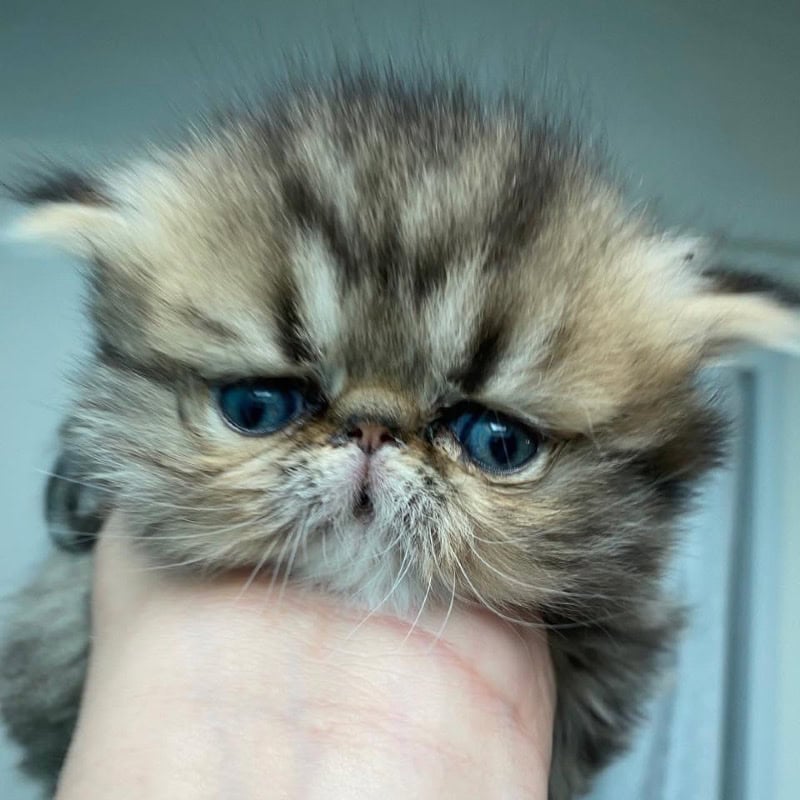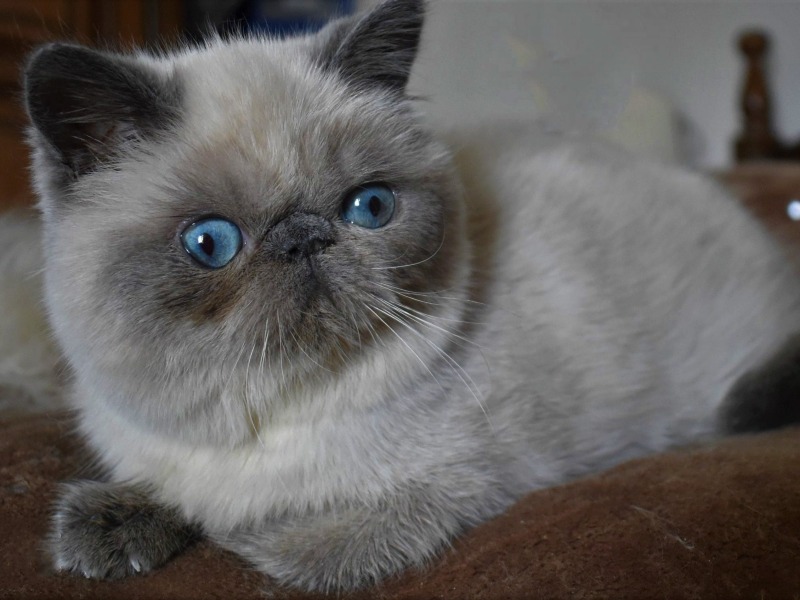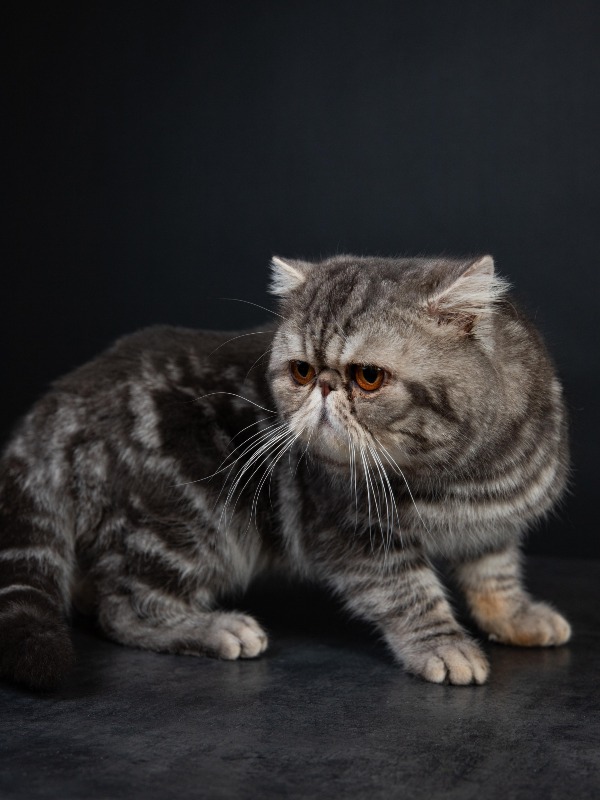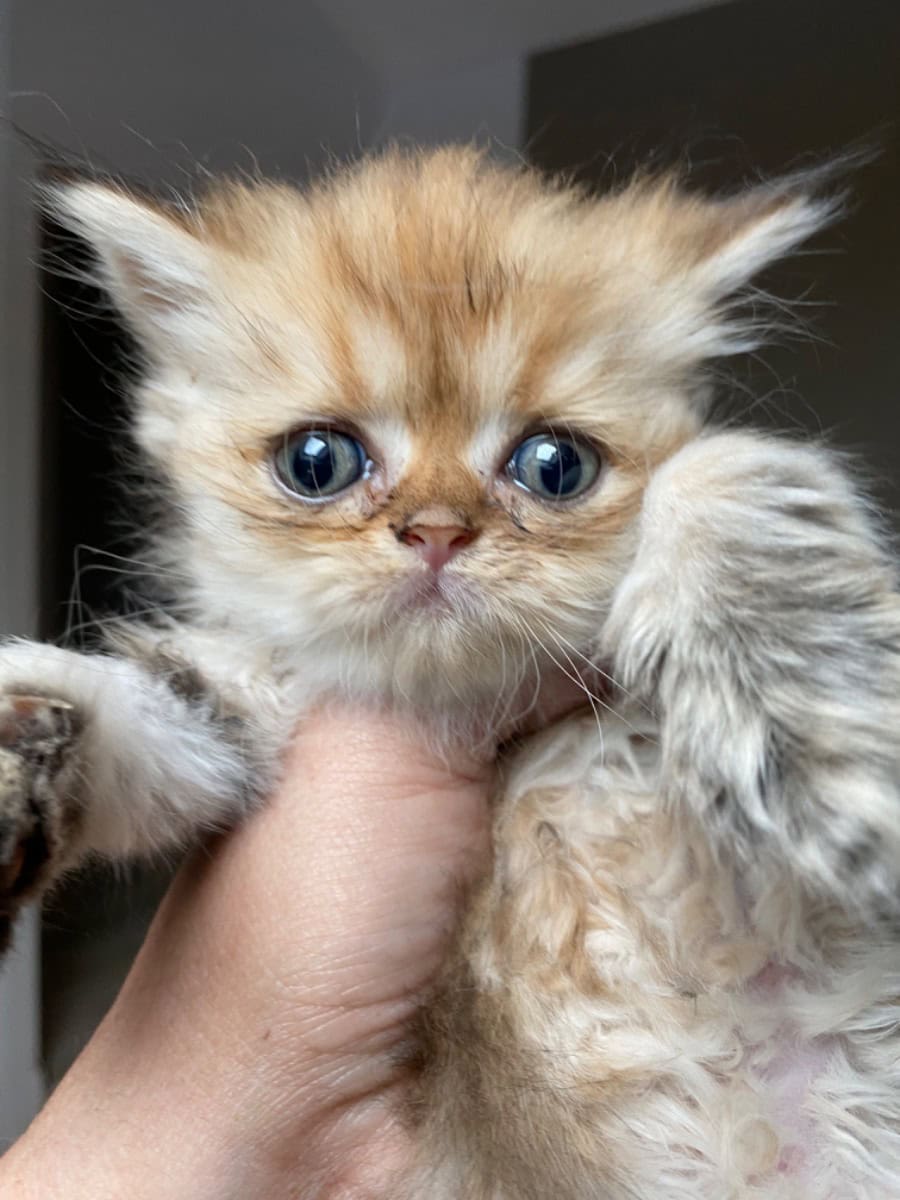Persian
Autres noms : Persian colour point, Persian siamese, Persian tabby, Persian hymalayan
Discover the Persian cat, a majestic breed renowned for its long, silky fur, gentle face, and expressive eyes. Ideal for cat lovers seeking a calm and affectionate companion, the Persian combines beauty, a serene temperament, and elegance.
Awareness of acquiring an animal
Adoption and breeding of cats should always be guided by a sincere attachment to the animal and an understanding of its specific needs. Whether for leisure or passion, it is essential to provide a safe, enriching, and suitable environment. Avoid any impulsive acquisition that could harm their well-being. Cats require attention, regular healthcare, and a secure space. Commit to providing them with a quality life by being a conscientious and informed owner or breeder.
To learn more about animal welfare, we invite you to consult our FAQ by clicking the button below:
Origins and history
The origins of the Persian cat breed trace back to ancient times, with early evidence found in Persia, present-day Iran, where these felines were valued for their beauty and calm demeanor. The first records of this breed date back to the 1600s when cat smugglers brought specimens to Europe. Their distinctive appearance, featuring long, silky fur and a flat face, quickly captivated feline enthusiasts across the continent.
In the 19th century, the popularity of Persian cats surged, particularly during cat shows. Breeders began selecting for specific traits, making the fur even denser and the appearance more typical. This selection process led to the standardization of the breed, establishing the physical traits commonly associated with Persians today.
Throughout the 20th century, the breed continued to evolve, facing health challenges related to its morphology, such as respiratory issues. Nevertheless, Persian cats remained sought-after companions, treasured for their gentle and affectionate temperament. Their presence in popular culture, particularly in films and literature, reinforced their image as elegant and royal felines.
Physical characteristics
The Persian cat is recognized for its majestic appearance and elegant demeanor. Its head is wide and rounded, with a flat forehead that gives it a gentle and calm expression. The eyes, often large and round, can come in a variety of colors, ranging from gold to blue, adding to its charm. The nose is short and turned up, which accentuates the distinctive look of the face.
The body is robust and well-muscled, with a solid bone structure. The legs are short and powerful, ending in round, compact feet. The tail is of medium length, elegantly adorned with fur, which enhances the impression of a sturdy physique.
One of the most distinctive features of this breed is its long, luxurious coat. It is dense, silky, and requires regular grooming to prevent tangles. The colors and patterns can vary significantly, ranging from solid shades to tabby and bicolor patterns. Overall, the Persian cat stands out for its impressive beauty and delicate appearance that captivates cat lovers.
Character
The Persian cat breed is known for its gentle and calm personality. These felines are generally recognized for their affectionate nature, often seeking the company of their owners. They thrive in a tranquil environment and enjoy spending time being petted. Their calm temperament makes them ideal companions for those who appreciate a serene atmosphere at home.
Furthermore, Persian cats are often quite reserved with strangers, preferring to observe from a distance before getting closer. This does not mean they are shy; rather, they take their time to adapt to new situations. Their quiet nature generally makes them less inclined to engage in excessive play or destructive behaviors.
Regarding their activity level, these felines do not require much physical exercise. They prefer moderate playtime and enjoy settling into comfortable spots to rest. This behavior is sometimes accompanied by a certain need for routine, which allows them to feel secure and at ease in their environment. In summary, cats of this breed bring a tranquility and gentleness that attract many cat lovers.
Life expectancy
The life expectancy of Persian cats generally ranges between 12 and 15 years, although there are cases where some individuals can live up to 20 years with proper care. This breed is valued for its majestic appearance and gentle temperament, but it also has predispositions to certain health conditions that can affect its longevity.
The health of Persian cats can be impacted by their morphology, particularly their flat face and short nose. This anatomical feature can lead to respiratory and dental issues. Additionally, they are prone to developing hereditary diseases, such as polycystic kidney disease, which can affect their lifespan.
Diet plays a crucial role in their health. A balanced diet tailored to their specific nutritional needs can help prevent obesity and promote their overall well-being. Regular veterinary visits are also essential for the early detection of any potential health problems and to maintain good health in the long term. By taking care of these aspects, owners can contribute to a longer and healthier life for their feline companions.
Exercise and activity needs
Persian cats are popular pets, appreciated for their elegant appearance and calm temperament. When it comes to their exercise and activity needs, it is essential to understand that this breed generally has a moderate energy level. Unlike other, more active breeds, Persians prefer gentle and relaxing activities.
Interactive play is recommended to stimulate their curiosity while minimizing physical effort. Chew toys, feather wands, or paper balls can capture their attention without requiring intensive play sessions. It is better to have short play moments several times a day rather than one long exercise session.
Furthermore, although Persian cats are not avid climbers, it is beneficial to provide them with places to perch or hide. Cat trees or shelves can offer them a space to relax while promoting their mental well-being. The key is to ensure that they have an enriching environment where they can play, explore, and rest at their own pace.
Recommended diet
The diet of Persian cats requires special attention due to their physical characteristics and specific needs. It is essential to provide them with quality food that meets their nutritional requirements. A diet rich in high-quality proteins is crucial, as cats are obligate carnivores. They need proteins to maintain their muscle mass and energy.
Fats also play a crucial role, as they are a concentrated source of energy. It is recommended to choose healthy fats, such as those from fish or poultry oils, which contribute to skin and coat health. Given that Persian cats have dense, long fur, it is vital to incorporate omega-3 and omega-6 fatty acids to prevent skin issues and the formation of hairballs.
When it comes to carbohydrates, it is advisable to limit their quantity. Excessive levels can lead to weight and health problems. It is preferable to opt for foods containing fiber, which help with digestion and the management of hairballs.
Finally, hydration is essential. Encourage your cat to drink fresh water and consider incorporating wet food into their diet. This helps to maintain good kidney health. A balanced diet that adheres to these principles will promote the well-being and longevity of your feline companion.
Training and obedience
The education and training of Persian cats require a gentle and patient approach. These felines, known for their calm temperament, thrive in a peaceful environment. It is crucial to start their education at a young age to establish good habits. Interactive play sessions are not only essential for their physical well-being, but they also strengthen the bond between the cat and its owner.
When it comes to socialization, it is important to gradually expose them to various stimuli such as other animals, sounds, and people. This helps to minimize the potential shyness of some individuals. Using rewards in the form of treats or petting reinforces desired behaviors. Training sessions should be short but regular, as these cats can quickly lose interest.
Cleanliness is a vital aspect of their education. It is recommended to keep their litter box clean and accessible, while encouraging them to use it from a young age. Grooming is also an integral part of their routine, requiring a patient approach to get the cat used to being brushed regularly. By following these principles, one encourages a harmonious and balanced development, both behaviorally and physically.
Behavior with children
Persian cats are often appreciated for their calm and gentle temperament, which generally makes them compatible with children. Their placid nature creates a reassuring environment conducive to kind interactions. However, it is essential to ensure that young children understand how to interact with these sensitive animals.
These cats prefer a peaceful atmosphere. Children should be taught to respect the cat's space and to avoid sudden movements that could stress it. Calm games and cuddling moments can strengthen the bonds between the child and the cat, thus creating a positive and affectionate relationship.
It is also important to monitor the encounters between young children and the cat. Even though it is usually placid, every animal has its limits. By teaching children to recognize signs of stress or discomfort, a harmonious coexistence can be promoted. Therefore, with proper education and supervision, Persian cats can become valuable companions for children.
Compatibility with Other Animals
The Persian cat breed is known for its calm and affectionate temperament, making it an interesting choice for households with other pets. Their gentle nature generally allows them to get along with dogs and other cats, as long as these pets are not too excitable or noisy. A Persian cat can adapt to the presence of a friendly and well-socialized dog, especially if introductions are made gradually.
It is advisable to introduce a Persian cat to other animals from a young age. This helps establish good relationships and reduce stress. A calm and predictable environment promotes harmonious cohabitation. Persian cats can be reserved, so supervised meetings and retreat areas can be beneficial. They also enjoy having their personal space, which is important to consider.
However, cohabitation may become more complex if the other animals are dominant or too energetic. In this case, it is crucial to monitor their interactions and intervene if necessary. With patience, it is possible to create a home where all animals feel safe and happy, allowing for a harmonious life together.
Grooming needs
The Persian cat is famous for its beauty and its long, luxurious fur. However, this coat requires rigorous and frequent maintenance. Daily brushing is essential to prevent tangles and the accumulation of dead hair. Indeed, without regular brushing, tangles can become painful and lead to skin problems. It is recommended to use a long-haired brush or a specific comb for cats to keep the coat healthy.
In addition to brushing, professional grooming can be considered every two to three months. This grooming helps maintain the fur in good condition, especially if the family member is particularly sensitive to handling or brushing. Nail care is also important, as long nails can cause domestic accidents or injuries.
Finally, it is crucial to monitor the cat's eyes and ears. Cats of this breed are prone to ocular secretions, which may require regular cleaning. In summary, grooming and caring for this cat require time and commitment but are essential to ensure its health and well-being.
Health
The health of Persian cats requires special attention due to their specific morphology. Their flat faces, while charming, lead to respiratory issues, particularly difficulties in breathing through the nose. These cats are prone to conditions such as brachycephalic syndrome, which can result in airway obstructions and reduced exercise tolerance.
Additionally, the breed is predisposed to certain eye conditions, such as ankylosa, a disease that can cause corneal damage and vision problems. Excessive tearing and eye infections are also common, necessitating regular care to prevent complications.
Kidney problems, particularly polycystic kidney disease, represent another major concern. This hereditary condition can affect long-term kidney function. A balanced diet and regular veterinary check-ups are essential for early detection of these issues.
Finally, their thick, long fur requires frequent grooming to prevent tangles and reduce the risk of skin infections. By taking the right precautions and ensuring their well-being, owners can provide a healthy and happy life for their four-legged companions.
Environment and habitat
The Persian cat is a breed distinguished by its long, luxurious coat and flat face. Its ideal environment should provide a calm and quiet atmosphere, as these cats are sensitive to loud noises and quick movements. They generally prefer interior spaces where they can feel safe, away from external dangers.
Their habitat should be well arranged, with cozy corners for resting, scratching posts to maintain their claws, and interactive toys to stimulate their curiosity. The importance of comfort is paramount for this breed, which appreciates warm and cozy places. It is advisable to have several spots where these cats can rest, such as baskets or blankets.
In terms of climate, Persian cats are better suited to temperate environments. They may struggle to adapt to extreme conditions, whether it be intense heat or severe cold. Therefore, regulating the temperature of their habitat is crucial for their well-being. An environment conducive to their flourishing should balance comfort, safety, and stimulation.
Name ideas
Choosing a name for a Persian cat is a fun task, but it also requires some thought. A good name should reflect the personality, appearance, and unique charm of this breed. For instance, Persian cats are often perceived as graceful, gentle, and elegant, which can guide the choice toward names that evoke sophistication. It's also important that the name is easy to pronounce and remember, both for you and your pet. Avoid names that are too long or complicated, as they might confuse your cat when you call it.
To assist you in this endeavor, here are some suggestions that suit the beauty and character of Persian cats: Cloud, Sapphire, Mocha, Bubble, Cuddle, Flake, Velvet, Doll, Diamond, Star, Dear, Gem, Frost, Coco, and Princess. Each of these names evokes a quality that may be fitting for a feline of this breed, whether it's their luxurious fur, tenderness, or majestic appearance. Take the time to say these names out loud and see which sound fits your four-legged companion best.
Average purchase price
The purchase price of a Persian cat varies significantly based on several factors. Generally, the initial prices for acquiring a cat of this breed typically range from €500 to €1,500. This price range mainly depends on the breeder's reputation, the animal's specific characteristics, and its lineage. A pedigree cat with a prestigious family tree can reach much higher prices.
Age and physical characteristics also play a crucial role in determining the cost. Kittens, which are more sought after, are often more expensive than adults. Additionally, traits such as coat color, eye color, and head shape can influence the price. Specimens that meet breed standards, meaning they conform to show criteria, are generally more expensive.
It is also important to consider the additional costs associated with acquiring an animal. Expenses for health care, food, accessories, and grooming make up a significant part of the long-term budget to plan for. Therefore, it is essential to carefully consider your decision before adopting a cat of this breed.
Expenses
Owning a Persian cat involves several monthly expenses that are essential to consider in order to ensure the well-being of the animal. Costs can vary depending on the region, individual choices, and the specific needs of each animal.
First of all, food constitutes a significant portion of the expenses. It is recommended to opt for high-quality food specially formulated for cats of this breed. Expect to spend between 30 and 60 euros per month for suitable food, depending on the brands and types of products chosen.
Next, veterinary care and disease prevention must also be taken into account. Plan for about 15 to 30 euros monthly for vaccinations, anti-parasitics, and possibly pet health insurance.
Hygiene costs, particularly grooming, represent another expense. Persian cats require regular brushing and may need professional grooming, which can amount to around 30 euros per month.
Finally, don't forget about accessories and toys, which can cost between 10 and 20 euros monthly. In summary, the average budget for a Persian cat can range between 100 and 140 euros per month, not including unexpected expenses related to health or other specific needs.
Destination and usage
Persian cats are often chosen as pets due to their calm and affectionate nature. Their gentle temperament makes them ideal for families with children, as they are generally patient and tolerant. These felines enjoy human companionship and easily bond with their owners, developing very strong emotional ties.
These cats adapt well to various home environments, whether it's apartments or houses with gardens. They like cozy spaces and can be placed in quiet areas where they feel safe. Persian cat owners should ensure they provide a soothing environment, with comfy spots for napping, which they particularly enjoy.
In terms of usage, Persian cats are often associated with wellness and relaxation practices. Their soft and silky fur and their laid-back behavior make them ideal companions for cuddle time. Additionally, their calming presence helps reduce stress and anxiety, making them true wellness allies within households. In summary, these felines are precious companions who bring joy and serenity to those around them.
Legislation and regulation
The legislation and regulations regarding the Persian cat breed vary considerably from country to country, reflecting cultural and legal differences. In several European countries, specific breeding standards are in place to protect the health and well-being of the animals. These regulations often stipulate requirements for breeding conditions, veterinary care, and health monitoring of the cats.
In the United States, there is no specific federal legislation regarding the breed, but many animal protection and welfare organizations recommend adhering to responsible breeding practices. Breeders are often required to follow ethical standards and to refrain from breeding individuals with genetic health issues.
In Asia, some countries, like Japan, emphasize the promotion of specific breeds in beauty contests. However, this can also lead to concerns about the health of the animals, as selection may favor aesthetic characteristics at the expense of well-being.
Finally, it is essential to highlight that, regardless of the country, owners are encouraged to adopt shelter animals and prioritize responsible adoption, thereby contributing to reducing animal overpopulation and promoting ethical treatment of animals.
Official recognition
The official recognition of Persian cats varies significantly from country to country. In many nations, this breed is highly valued, and its breed standards are well established by feline organizations. For example, in the United States and Europe, several recognized dog and cat federations, such as the CFA or FIFe, have set specific criteria regarding the physical appearance, temperament, and health characteristics of these animals.
In other regions, recognition is less formal. In some countries in Asia or Latin America, Persian cats are often appreciated for their majestic and gentle appearance, but breeding standards may be less rigorous, sometimes leading to inappropriate breeding practices. This can pose challenges for the health and well-being of the animals, given the common genetic issues within this breed.
Finally, awareness of responsible breeding and the preservation of animal health is steadily increasing worldwide. Breed clubs and animal protection associations often work to educate the public about best practices related to the breeding and care of Persian cats, thereby contributing to a more informed and ethical recognition of this breed.
Pedigrees
To obtain a pedigree for the Persian cat breed, there are several organizations and clubs that can issue this official document. In France, the Société Centrale Féline (SCF) is one of the main organizations responsible for managing pedigrees. It establishes standards for various cat breeds, including the Persian, and organizes cat shows where cats can be judged according to these criteria.
On an international level, the Fédération Internationale Féline (FIFe) is another major club that issues pedigrees. This organization brings together several national clubs and imposes strict standards for the breeding and selection of cats, thus ensuring the quality and authenticity of the bloodlines.
The Cat Fanciers' Association (CFA) is a renowned club based in the United States that plays a crucial role in recognizing the Persian breed. It offers pedigree services and organizes specific competitions for various breed profiles, thereby providing valuable recognition to breeders.
These organizations ensure that breeders adhere to breed standards and contribute to the preservation and improvement of the characteristics of the Persian cat. Obtaining a pedigree from these clubs not only proves the authenticity of the lineage but also ensures that the Persian cat conforms to the expected health and behavioral standards for this breed.
Prohibitions
The breeding and ownership of certain cat breeds, including long-haired and flat-faced varieties, may be subject to regulations in several countries due to health concerns. Persian cats, with their unique morphology, are often prone to various health issues such as respiratory disorders and renal diseases. This has led some countries to consider bans on their breeding to protect animal welfare.
Other countries take a softer approach by imposing strict rules regarding breeding and care conditions. These regulations aim to ensure that animals do not suffer due to their physical characteristics. Breeders must adhere to rigorous health standards and provide proof of their animals' health before they can sell them.
Finally, the growing awareness of animal rights and ethical breeding practices may also influence future laws. Discussions around genetic experimentation and genetic engineering in the breeding of these animals could also play a crucial role in the formulation of new regulations on a global scale.
Breeders of Persian
Want to see more breeders of Persian?
Check out the page of our directory listing all breeders of PersianClassified Ads of Persian
Breed clubs of persian
No of persian breed clubs are currently registered on Preeders.
If you would like to highlight your breed club, sign up for free now and be the first to appear on this page.






